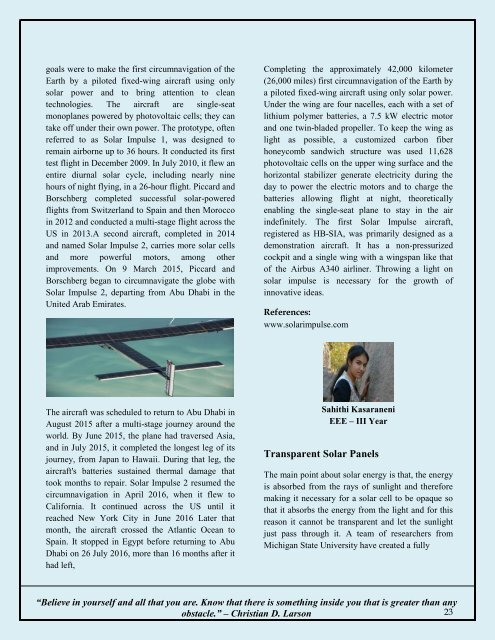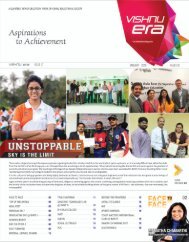B-Smart_July'17
Create successful ePaper yourself
Turn your PDF publications into a flip-book with our unique Google optimized e-Paper software.
goals were to make the first circumnavigation of the<br />
Earth by a piloted fixed-wing aircraft using only<br />
solar power and to bring attention to clean<br />
technologies. The aircraft are single-seat<br />
monoplanes powered by photovoltaic cells; they can<br />
take off under their own power. The prototype, often<br />
referred to as Solar Impulse 1, was designed to<br />
remain airborne up to 36 hours. It conducted its first<br />
test flight in December 2009. In July 2010, it flew an<br />
entire diurnal solar cycle, including nearly nine<br />
hours of night flying, in a 26-hour flight. Piccard and<br />
Borschberg completed successful solar-powered<br />
flights from Switzerland to Spain and then Morocco<br />
in 2012 and conducted a multi-stage flight across the<br />
US in 2013.A second aircraft, completed in 2014<br />
and named Solar Impulse 2, carries more solar cells<br />
and more powerful motors, among other<br />
improvements. On 9 March 2015, Piccard and<br />
Borschberg began to circumnavigate the globe with<br />
Solar Impulse 2, departing from Abu Dhabi in the<br />
United Arab Emirates.<br />
Completing the approximately 42,000 kilometer<br />
(26,000 miles) first circumnavigation of the Earth by<br />
a piloted fixed-wing aircraft using only solar power.<br />
Under the wing are four nacelles, each with a set of<br />
lithium polymer batteries, a 7.5 kW electric motor<br />
and one twin-bladed propeller. To keep the wing as<br />
light as possible, a customized carbon fiber<br />
honeycomb sandwich structure was used 11,628<br />
photovoltaic cells on the upper wing surface and the<br />
horizontal stabilizer generate electricity during the<br />
day to power the electric motors and to charge the<br />
batteries allowing flight at night, theoretically<br />
enabling the single-seat plane to stay in the air<br />
indefinitely. The first Solar Impulse aircraft,<br />
registered as HB-SIA, was primarily designed as a<br />
demonstration aircraft. It has a non-pressurized<br />
cockpit and a single wing with a wingspan like that<br />
of the Airbus A340 airliner. Throwing a light on<br />
solar impulse is necessary for the growth of<br />
innovative ideas.<br />
References:<br />
www.solarimpulse.com<br />
The aircraft was scheduled to return to Abu Dhabi in<br />
August 2015 after a multi-stage journey around the<br />
world. By June 2015, the plane had traversed Asia,<br />
and in July 2015, it completed the longest leg of its<br />
journey, from Japan to Hawaii. During that leg, the<br />
aircraft's batteries sustained thermal damage that<br />
took months to repair. Solar Impulse 2 resumed the<br />
circumnavigation in April 2016, when it flew to<br />
California. It continued across the US until it<br />
reached New York City in June 2016 Later that<br />
month, the aircraft crossed the Atlantic Ocean to<br />
Spain. It stopped in Egypt before returning to Abu<br />
Dhabi on 26 July 2016, more than 16 months after it<br />
had left,<br />
Sahithi Kasaraneni<br />
EEE – III Year<br />
Transparent Solar Panels<br />
The main point about solar energy is that, the energy<br />
is absorbed from the rays of sunlight and therefore<br />
making it necessary for a solar cell to be opaque so<br />
that it absorbs the energy from the light and for this<br />
reason it cannot be transparent and let the sunlight<br />
just pass through it. A team of researchers from<br />
Michigan State University have created a fully<br />
“Believe in yourself and all that you are. Know that there is something inside you that is greater than any<br />
obstacle.” – Christian D. Larson<br />
23





